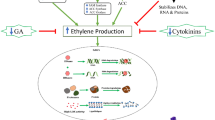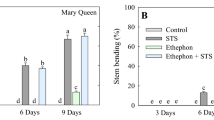Abstract
Tweedia caerulea flowers are sensitive to ethylene and the closing of the flowers, a characteristic of senescence, is accelerated by exposure to ethylene. T. caerulea flowers were continuously treated with ethanol at concentrations of 0, 2, 4, 6, 8, 10 or 12 %, and treatment levels at 4 % and above showed delayed closing. Ethanol accelerated climacteric increase in ethylene production from flowers. Although ethylene production was higher in gynoecium than in petals, ethanol treatment accelerated ethylene production by both organs. Exposure to ethylene increased autocatalytic ethylene production, and production was further accelerated by ethanol treatment. When flowers treated with ethanol were exposed to ethylene, senescence was delayed compared to that for untreated flowers, suggesting that ethanol reduces the sensitivity of flowers to ethylene. These results indicate that treatment with ethanol delays petal senescence in cut T. caerulea flowers, possibly through reduced sensitivity to ethylene.






Similar content being viewed by others
References
Armitage AM, Seager NG, Warrington IJ, Greer DH, Reyngoud J (1990) Responses of Oxypetalum caeruleum to irradiance, temperature, and photoperiod. J Am Soc Hort Sci 115:910–914
Beaulieu JC, Peiser G, Saltveit ME (1997) Acetaldehyde is a causal agent responsible for ethanol-induced ripening inhibition in tomato fruit. Plant Physiol 113:431–439
Dilley DR, Carpenter WJ (1975) The role of chemical adjuvants and ethylene synthesis on cut flower longevity. Acta Hort 41:117–132
Doi M, Nakagawa Y, Watanabe S, Aoe K, Inamoto K, Imanishi H (2003) Ethylene-induced leaf yellowing in cut chrysanthemums (Dendranthema grandiflora Kitamura). J Jpn Soc Hort Sci 72:533–535
Heins RD (1980) Inhibition of ethylene biosynthesis and senescence in carnation by ethanol. J Am Soc Hort Sci 105:141–144
Heins RD, Blakely N (1980) Influence of ethanol on ethylene biosynthesis and flower senescence of cut carnation. Sci Hort 13:361–369
Hiraya T, Shimizu H, Ichimura K (2002a) Role of ethylene in senescence of cut Oxypetalum florets. J Jpn Soc Hort Sci 71:59–61
Hiraya T, Shimizu H, Ichimura K (2002b) Effects of STS, 1-MCP and sucrose on the vase life of cut Oxypetalum caeruleum flowers. Hort Res (Japanese) 1:67–70
Ichimura K, Goto R (2000) Acceleration of senescence by pollination of cut ‘Asuka-no-nami’ Eustoma flowers. J Jpn Soc Hort Sci 69:166–170
Ichimura K, Hiraya T (1999) Effect of silver thiosulfate complex (STS) in combination with sucrose on the vase life of cut sweet pea flowers. J Jpn Soc Hort Sci 68:23–27
Ichimura K, Suto K (1999) Effects of the time of sucrose treatment on vase life, soluble carbohydrate concentrations and ethylene production in cut sweet pea flowers. Plant Growth Regul 28:117–122
Itamura H (1986) Relationships between fruit softening, respiration and ethylene production after deastringent treatment by alcohol in Japanese persimmon (Diospyros kaki Thunb. Var. Hiratanenashi) fruits harvested at various stages. J Jpn Soc Hort Sci 55:89–98
Jones ML, Woodson WR (1999) Interorgan signaling following pollination in carnations. J Am Soc Hort Sci 124:598–604
Nishikawa F, Iwama T, Kato M, Hyodo H, Ikoma Y, Yano M (2005) Effect of sugars on ethylene synthesis and responsiveness in harvested broccoli florets. Postharvest Biol Technol 36:157–165
Ohno H (1991) Participation of ethylene in flower bud blasting induced by high temperature in Cymbidium (Orchidaceae). J Jpn Soc Hort Sci 60:415–420
Petridou M, Voyiatzi C, Voyiatzis D (2001) Methanol, ethanol and other compounds retard leaf senescence and improve the vase life and quality of cut chrysanthemum flowers. Postharvest Biol Technol 23:79–83
Podd LA, van Staden J (1999a) Is acetaldehyde the causal agent in the retardation of carnation flower senescence by ethanol? J Plant Physiol 154:351–354
Podd LA, van Staden J (1999b) The use of acetaldehyde to control carnation flower longevity. Plant Growth Regul 28:175–178
Pun UK, Rowe RN, Rowarth JS, Barnes MF, Dawson CO, Heyes JA (1999) Influences of ethanol on the climacteric senescence in some cultivars of carnation. N Z J Crop Hort Sci 2:69–77
Pun UK, Rowarth JS, Barnes MF, Heyes JA (2001a) The role of ethanol or acetaldehyde in the biosynthesis of ethylene in carnation (Dianthus caryophyllus L.) cv. Yellow Candy. Postharvest Biol Technol 21:235–239
Pun UK, Rowarth JS, Barnes MF, Heyes JA, Rowe RN, Dawson CO (2001b) The influence of exogenous acetaldehyde solution on the vase life of two carnation (Dianthus caryophyllus L.) cultivars in the absence or presence of exogenous ethylene. Plant Growth Regul 34:267–271
Shibuya K, Yoshioka T, Hashiba T, Satoh S (2000) Role of the gynoecium in natural senescence of carnation (Dianthus caryophyllus L.) flowers. J Exp Bot 51:2067–2073
Shimizu H, Ichimura K (2005) Effects of silver thiosulfate complex (STS), sucrose and their combination on the quality and vase life of cut Eustoma flowers. J Jpn Soc Hort Sci 74:381–385
ten Have A, Woltering EJ (1997) Ethylene biosynthetic genes are differentially expressed during carnation (Dianthus caryophyllus L.) flower senescence. Plant Mol Biol 34:89–97
Veen H (1979) Effects of silver on ethylene synthesis and action in cut carnations. Planta 145:467–470
Whitehead CS, Halevy AH, Reid MS (1984) Roles of ethylene and 1-aminocyclopropane-1-carboxylic acid in pollination and wound-induced senescence of Petunia hybrida flowers. Physiol Plant 61:643–648
Woodson WR, Park KY, Drory A, Larsen PB, Wang H (1992) Expression of ethylene biosynthetic pathway transcripts in senescing carnation flowers. Plant Physiol 99:526–532
Wu MJ, Zacarias L, Saltveit ME, Reid MS (1992) Alcohols and carnation senescence. HortScience 27:136–138
Zieslin N, Gottesman V (1983) Involvement of ethylene in the abscission of flowers and petals of Leptospermum scoparium. Physiol Plant 58:114–118
Acknowledgments
We thank Dr. W. G. van Doorn (Wageningen University and Research Centre) for his advice on this work. UKP gratefully acknowledges support of a postdoctoral fellowship from the Japanese Society for the Promotion of Science.
Author information
Authors and Affiliations
Corresponding author
Rights and permissions
About this article
Cite this article
Pun, U.K., Niki, T. & Ichimura, K. Ethanol reduces sensitivity to ethylene and delays petal senescence in cut Tweedia caerulea flowers. Plant Growth Regul 69, 125–130 (2013). https://doi.org/10.1007/s10725-012-9755-6
Received:
Accepted:
Published:
Issue Date:
DOI: https://doi.org/10.1007/s10725-012-9755-6




